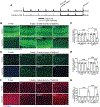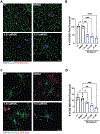Antiretroviral treatment reveals a novel role for lysosomes in oligodendrocyte maturation
- PMID: 36718947
- PMCID: PMC10724866
- DOI: 10.1111/jnc.15773
Antiretroviral treatment reveals a novel role for lysosomes in oligodendrocyte maturation
Abstract
White matter deficits are a common neuropathologic finding in neurologic disorders, including HIV-associated neurocognitive disorders (HAND). In HAND, the persistence of white matter alterations despite suppressive antiretroviral (ARV) therapy suggests that ARVs may be directly contributing to these impairments. Here, we report that a frontline ARV, bictegravir (BIC), significantly attenuates remyelination following cuprizone-mediated demyelination, a model that recapitulates acute demyelination, but has no impact on already formed mature myelin. Mechanistic studies utilizing primary rat oligodendrocyte precursor cells (OPCs) revealed that treatment with BIC leads to significant decrease in mature oligodendrocytes accompanied by lysosomal deacidification and impairment of lysosomal degradative capacity with no alterations in lysosomal membrane permeability or total lysosome number. Activation of the endolysosomal cation channel TRPML1 prevents both lysosomal deacidification and impairment of oligodendrocyte differentiation by BIC. Lastly, we show that deacidification of lysosomes by compounds that raise lysosomal pH is sufficient to prevent maturation of oligodendrocytes. Overall, this study has uncovered a critical role for lysosomal acidification in modulating oligodendrocyte function and has implications for neurologic diseases characterized by lysosomal dysfunction and white matter abnormalities.
Keywords: ART; HAND; lysosome; oligodendrocyte; remyelination.
© 2023 International Society for Neurochemistry.
Conflict of interest statement
Conflict of Interest statement
The authors declare no competing financial interest
Figures










References
-
- Ballabio A, Bonifacino JS (2020) Lysosomes as dynamic regulators of cell and organismal homeostasis. Nat. Rev. Mol. Cell Biol 21, 101–118. - PubMed
-
- Bankston AN, Forston MD, Howard RM, Andres KR, Smith AE, Ohri SS, Bates ML, Bunge MB, Whittemore SR (2019) Autophagy is essential for oligodendrocyte differentiation, survival, and proper myelination. Glia 67, 1745–1759. - PubMed
Publication types
MeSH terms
Substances
Grants and funding
LinkOut - more resources
Full Text Sources

